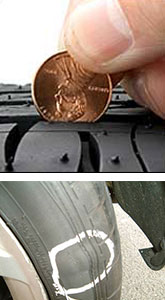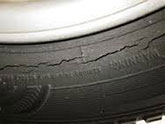
| |
|
Question: What is the only part of your rig that touches the road? Hopefully the answer is just your tires! Braking, handling, ride and safety all depend on your tires. So it is important that you inspect them regularly. What should you be looking for? Here are some suggestions. For starters, examine the tires’ tread. The primary purpose of the tread is to divert water from beneath the tire to improve traction. Make note of any irregular tread wear. This could indicate a wheel misalignment, the need for a tire rotation or both. Uneven tread wear is a sign that you may need to take your rig in for servicing. Have them inspect your suspension and make corrections if necessary BEFORE you replace your tires. Make it a point to inspect your tires monthly. Take the penny test Be sure to check for any abnormal bulges or "bubbles" in the sidewall of the tire. A sidewall bulge indicates that the rigid internal frame of the tire has been damaged and cracked, allowing air pressure to reach the flexible outer layers of the tire. Such damage could be caused by driving through a large pothole or over a curb, or by driving with low tire pressure. Any tires with sidewall bulges should be replaced immediately, regardless of the tread status. Watch for “dry rot” Finally, while your tires may look fine on the outside, they still could be weakened by age. A common rule of thumb in the RV community is that tires should be replaced every five to seven years — no matter how good they’re looking. You should have them professionally inspected yearly, starting at the five-year mark, or sooner if your unit has been in storage or “camped out” in a lot. In my next eblast I’ll show you an easy way to learn when your tires were made. Here’s a hint: It is stamped right on the sidewall. Till next time, I’m Rudy. Next:Taking care of your tires: dos and don'ts! |
You are receiving this email because you have asked to receieve industry related product and service announcements from Dicor Products. If you would no longer like to receive these emails you may unsubscribe at any time using the link below. |
 A good way to evaluate your tread is called the Penny Test. No, not the Penny from The Big Bang Theory, but a good old fashioned Abraham Lincoln one-cent piece. Simply insert a penny into your tire's tread groove with Lincoln's head upside down and facing you. If you can see the top of Lincoln's head, it's time to replace your tires.
A good way to evaluate your tread is called the Penny Test. No, not the Penny from The Big Bang Theory, but a good old fashioned Abraham Lincoln one-cent piece. Simply insert a penny into your tire's tread groove with Lincoln's head upside down and facing you. If you can see the top of Lincoln's head, it's time to replace your tires. One of the most critical signs that your tires should be replaced, is crazing or cracking in the flex area of the tire's sidewall. This sometimes referred to as “dry rot”. Literally, the rubber is breaking down. If any cracks are 2/32” or deeper the tire can be ripe for failure on the road, including a dangerous blowout, and should be replaced. Also look for internal components like steel or fabric body plies that may be exposed, and any scuffs or cuts that look like they could hamper tire performance or cause leaks.
One of the most critical signs that your tires should be replaced, is crazing or cracking in the flex area of the tire's sidewall. This sometimes referred to as “dry rot”. Literally, the rubber is breaking down. If any cracks are 2/32” or deeper the tire can be ripe for failure on the road, including a dangerous blowout, and should be replaced. Also look for internal components like steel or fabric body plies that may be exposed, and any scuffs or cuts that look like they could hamper tire performance or cause leaks.

